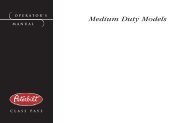MODEL 330 OPERATOR'S MANUAL - Peterbilt Motors Company
MODEL 330 OPERATOR'S MANUAL - Peterbilt Motors Company
MODEL 330 OPERATOR'S MANUAL - Peterbilt Motors Company
Create successful ePaper yourself
Turn your PDF publications into a flip-book with our unique Google optimized e-Paper software.
Operating Instructions<br />
Start–Up<br />
The following operations are to be performed by the driver.<br />
Performing these checks and following the maintenance procedures<br />
in this manual will help keep your Model <strong>330</strong> running<br />
properly.<br />
Approaching Your Vehicle<br />
• Check the overall appearance and condition. Are windows,<br />
mirrors, and lights clean and unobstructed?<br />
• Check beneath the vehicle. Are there signs of fuel, oil, or<br />
water leaks?<br />
• Check for damaged, loose, or missing parts. Are there<br />
parts showing signs of excessive wear or lack of lubrication?<br />
Have a qualified mechanic examine any questionable<br />
items and repair them without delay.<br />
• Check your load. Is it secured properly?<br />
Daily Checks<br />
NOTE: The following items (Engine Compartment,<br />
Chassis and Cab, and Prestart Checks)<br />
should be checked daily, as a minimum. They<br />
are in addition to, not in place of, federal motor<br />
Carrier Safety Regulations. These regulations<br />
may be purchased by writing to:<br />
Superintendent of Documents<br />
U.S. Government Printing Office<br />
Washington, DC 20402<br />
Engine Compartment Checks — Daily<br />
1. Engine Fluid Levels—add more if necessary.<br />
• Engine oil<br />
• Coolant (check while engine is cold)<br />
• Power steering fluid level<br />
• If your truck has hydraulic brakes, check the fluid<br />
level in the master cylinder reservoir. See page 158<br />
for more information.<br />
2. Engine Belt—check tension and condition of belts. This<br />
is important to ensure proper air compressor and engine<br />
operation.<br />
• Measure the belt tension at the longest span of the<br />
belt. See page 142 for further information on checking<br />
belt tension.<br />
NOTE: Deflection should be one belt thickness<br />
for each foot distance between the<br />
pulley centers.<br />
• If breaks or tears are found, the belt should be<br />
replaced before operating the vehicle.<br />
Model <strong>330</strong> PB1318 3/01 – 13 –
















